Anna Piaggi was one of the most influential and original figures in the fashion world. With her unmistakable style, her passion for colors and patterns and her boundless creativity, she inspired generations of designers, photographers and readers. In this article we take a look at the life and work of this extraordinary woman who was known as the Queen of Eccentricity.
Anna Piaggi was born in Milan in 1931. Even as a child, she showed a great interest in fashion and art. She studied literature and art history at the University of Milan and began working as a translator for the Mondadori publishing house in the 1950s. There she met her future husband Alfa Castaldi, a renowned fashion photographer.
In the 1960s, Anna Piaggi was appointed editor of the Italian women’s magazine Arianna. There she developed an innovative approach to fashion reporting, combining historical costumes with contemporary trends and selecting unconventional models such as actresses or singers. She also worked closely with legendary illustrator Antonio Lopez, who captured her outfits in his drawings.
In the 1970s, Anna Piaggi began her long association with Vogue Italia, for which she wrote until her death in 2012. She became famous for her double-page spreads, known as “D.P. Doppie Pagine di Anna Piaggi.” These were collages of text, photos, sketches and found objects that reflected her personal view of fashion. She wrote about everything from haute couture to street style, from historical figures to current events.
Anna Piaggi was not only a brilliant journalist, but also a style icon. She owned a huge collection of dresses, hats, shoes and accessories that she mixed and matched according to her own taste. She loved to play with colors, shapes and materials, reinventing herself every day. She often wore creations by her friends and admirers like Karl Lagerfeld, Vivienne Westwood or Stephen Jones.
Anna Piaggi was a pioneer of fashion culture and a source of inspiration for many. She was a woman who did not care about conventions or rules, but followed her own vision. She was a queen of eccentricity who enriched the world with her imagination.

